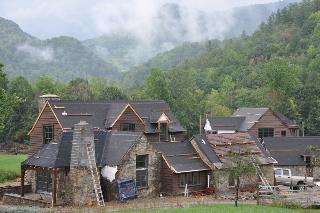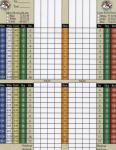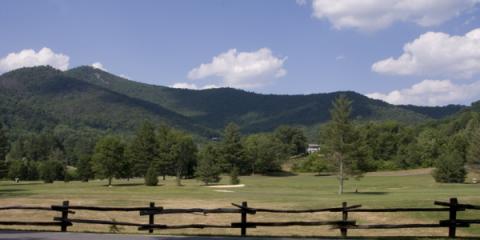
Homes in the Village section of Cold Mountain feature high-end materials and architecture as well as commanding views of the nearby mountains. (Photo provided by Cold Mountain)
The thing that hath been, it is that which shall be; and that which is done is that which shall be done: and there is no new thing under the sun. -- Book of Ecclesiastes
If you visit more than 100 real estate developments in a few years, as I have done, you realize that the formula from one community to the next is essentially the same: Choose an attractive piece of land near the coast, in the mountains or surrounding a lake; and promise a string of amenities that includes golf course, fitness center, tennis, pools, maybe spa and equestrian center (which residents pay for, one way or the other). Each development has at least one or more elements to recommend it, but it can be difficult to distinguish among them in terms of which will best suit our own personal needs and lifestyle. It comes down to feel rather than accountant-type analyses.
It was a refreshing change to visit Cold Mountain. The philosophy at the core of the Canton, NC, community is straightforward and reflects the natural instincts, and instincts for nature, of its young developer, Wilton Graves, whose grandfather is credited with helping develop Hilton Head Island in the 1950s. (His grandad's name is on the bridge that leads to the island.) Graves' father is also a developer. Cold Mountain, which lists its address in nearby Waynesville, is Graves' first project on his own, and he is committing body, soul and family to it. He, his wife and two children will be the first residents of the community when their home is finished in a few months
straightforward and reflects the natural instincts, and instincts for nature, of its young developer, Wilton Graves, whose grandfather is credited with helping develop Hilton Head Island in the 1950s. (His grandad's name is on the bridge that leads to the island.) Graves' father is also a developer. Cold Mountain, which lists its address in nearby Waynesville, is Graves' first project on his own, and he is committing body, soul and family to it. He, his wife and two children will be the first residents of the community when their home is finished in a few months
The theme ingredients at Cold Mountain -- and, yes, it is indeed the Cold Mountain of novel and movie fame -- are simply stated in a brief coda called "The Idea," Graves' own words about what he intends Cold Mountain to be. The three paragraphs rise above the customary brochure copy of most communities, speaking to the contradictions many of us feel when considering where we might spend the next couple of decades of our lives rather than our needs to surround ourselves with as many activities as possible. Here is "The Idea," short and sweet:
"Cold Mountain is about creating the modern rural life. It always bothered me that on Green Acres, there had to be a choice between city and country life. It made for memorable comedy, but a lack of compromise rarely produces positive results.
"Most of us have lived in urban environments and don't want to give up the benefits of urban life entirely. Yet, we crave a connection to the beauty of rural living. I wanted to manufacture a new option. One that didn't compromise all of my competing needs.
"Could I catch a trout on fly in the afternoon then that evening, ten minutes away, attend the theatre? Could a strong neighborhood feel be created while integrating the natural beauty of the land that has always been here? Yes, but only with the best architecture, building materials and sustainable practices."
Although some might quibble the statement is perhaps too succinct -- how, for example, do the best building materials, architecture and sustainability necessarily create a stronger neighborhood feel? -- elaboration and explanation is what I am here for. I spent three interesting hours at Cold Mountain with Graves and project manager Keith Jolly, and I have a good picture of what they are out to accomplish.
For the "best architecture, building materials and sustainable practices" part, Graves has engaged Summerour Associates, a youthful, Atlanta-based architectural firm with a studio just down the road from Cold Mountain, in Cashiers, NC. Summerour's award-winning designs focus mostly on high-end residences in the mountains and on the coast, although they are also currently working on the infrastructure at the Aetna Springs Golf Club in California's Napa Valley, a Tom Doak course. Summerour's work is not cheap, but Graves explains that the 25 people who have bought at Cold Mountain in the last two years understand the impact of high-level design and lasting materials on their homes' values. He expects the next 100 people to purchase a home in the community will understand it as well.
Cashiers, NC. Summerour's award-winning designs focus mostly on high-end residences in the mountains and on the coast, although they are also currently working on the infrastructure at the Aetna Springs Golf Club in California's Napa Valley, a Tom Doak course. Summerour's work is not cheap, but Graves explains that the 25 people who have bought at Cold Mountain in the last two years understand the impact of high-level design and lasting materials on their homes' values. He expects the next 100 people to purchase a home in the community will understand it as well.
"They won't have to worry about whether their neighbors are taking care of the exteriors of their homes," says Graves, "since the materials do not require maintenance. The roofs, for example, will last more than 75 years, so it will actually be cheaper in the long run than more conventional roofs, which must be replaced a few times."
Yes, but none of us will live in a home for 75 years. Agreed, says Graves, but he points out that if an owner sells in 20 years, the roof will still be perfect and, therefore, the value of the home will be that much more than a home down the road with a conventional roof that might be coming to the end of its useful life. Other touches in Cold Mountain's homes include copper flashing for all windows; radiant floors certified by LEED, the organization that rates energy efficiency; and supplementary geothermal heating and cooling.
"We have the answer for those who wonder, ‘If I buy a green home," says Graves, with a smile, "does it have to smell like patchouli?' No it doesn't."
The homes at Cold Mountain are custom designed and built, but they will look as if they belong together, featuring common elements such as slate and stone exteriors and the tile roofs.
"We are combining the classic with the sustainable," says Graves, "marrying Birkenstocks with wingtips."
Of course, well-made Birkenstocks and wingtips are high-end accessories, and although Graves prefers to talk
As Asheville and the surrounding areas draw more and more people, I am worried about traffic problems. It is a sad irony that people move to places to get away from traffic only to find that everyone else has followed them. That is why you see so many Florida license plates in the mountains of the Carolinas, and why some areas of the mountains are likely to mirror Florida's traffic problems in coming years. But, according to Graves, that is unlikely to happen on State Highway 276, which passes Cold Mountain's entrance and is the only path of ingress and egress for the community.
"Most of the land around us is too severe for new development," he says. "Towns like Knoxville and Asheville can expand out, but not the area around Cold Mountain. It is just too difficult to build here."
As for Highway 276, the two-lane road begins to twist and turn just south of the community, toward Brevard, making
Prices for homes of about 2,200 square feet begin just under $1 million, with land prices begining at roughly one-third of that. During my visit a couple of weeks ago, workmen were busy putting the finishing touches on smaller homes in the community's Village section, where prices start around $800,000. There is no minimum square footage for a home in the community -- one of them will be just 1,200 square feet, says Graves -- but he will limit the maximum to 8,000 square feet.
So what about the golf? Cold Mountain, in keeping with the fewer amenities is better philosophy, does not have a golf course, but directly across from the entrance to the community is a nice public track called Springdale Golf Club. I took a 45-minute tour of the course in a golf cart and was impressed with its condition and layout, although it certainly
Springdale's layout opens with a nice par 5 that requires a drive over a stream and then a second shot over an extension of that same stream. Long hitters might want to throttle back on the tee shot as the second stream is about 250 yards from the tee. Water, mostly in the form of streams, comes into play on the first four holes at Springdale and on 11 holes in total. The toughest hole on the course is the 414 yard par four 4th, with a stream the runs down the right side of the fairway a length of 280 yards, then crosses the fairway about 130 yards from the green, and finally proceeds down the left side and below the green. Nice hole.
In the novel (and movie) Cold Mountain, the hero struggles to return from the Civil War to the love of his life. On a promontory a few hundred yards inside the entrance to Cold Mountain, a rustic wooden fence surrounds a 300 square foot patch of green that looks out to the Blue Ridge Mountains in the distance and up to the hulking Cold Mountain itself. It is a favorite spot for area couples to exchange their wedding vows, and an apt metaphor for what Cold Mountain's developer is trying to accomplish -- to marry the old with the new, the rural with the urban, the relaxed with the vital, and Nature with the nature of peoples' souls.
Cold Mountain, Waynesville, NC. Tel: 877.265.4331. Web: ColdMountainLife.com. Contact me (use button at the top of this page) and I will be happy to introduce you to Wilton Graves, the inspiration behind Cold Mountain.

Springdale Golf Club provides a nice layout and excellent mountain views directly across the street from Cold Mountain's entrance.























